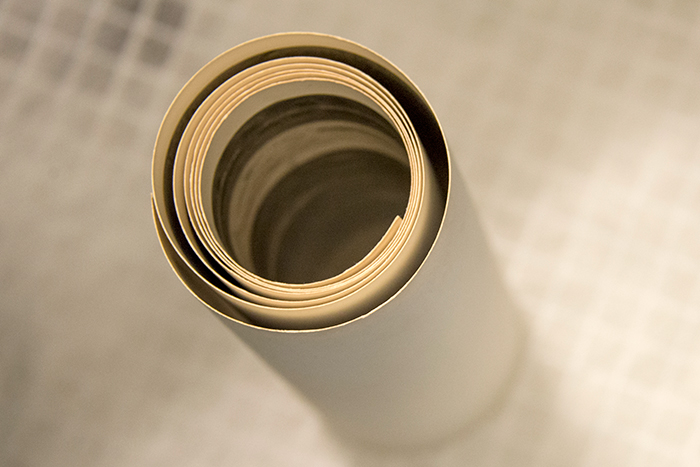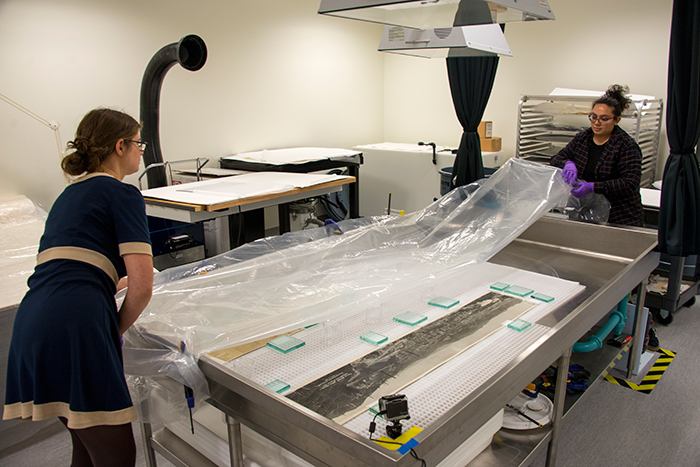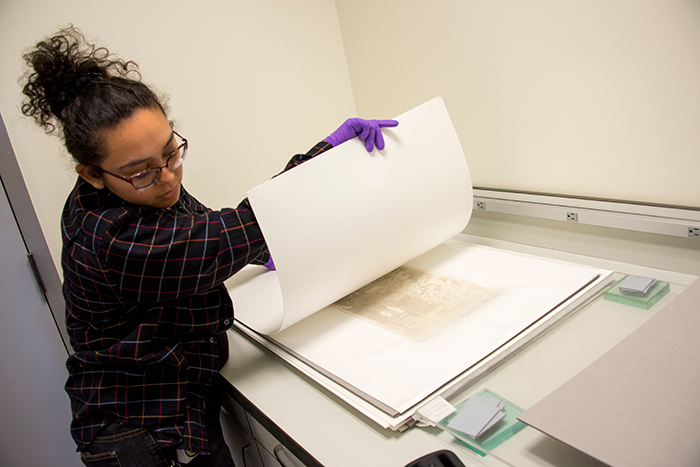
A tightly rolled panoramic photo before treatment. Photo by Kate Lain.
Storing large-format panoramic photos is challenging. Many of the panoramas that arrive at The Huntington have been tightly rolled for long periods, making it hard to properly catalog them or even view them.
One of the most time-intensive and gratifying projects that I completed as a summer intern in The Huntington’s conservation lab was the unrolling and flattening of 20 panoramic photographs. The photos were from the collection of Homer D. Crotty (1899–1972), a Los Angeles lawyer. One of Crotty’s clients was the Richfield Oil Company, which he represented when it went into receivership during the Great Depression. He was chair of the Board of Trustees at The Huntington between 1957 and 1972, and his papers were donated in 1990.

First step: Humidify the rolled panoramic photos in a modified trash bin. Photo by Kate Lain.
When I started this project, I didn’t even know what was in the photos. I had only a few clues from some of the panoramas that showed a location or a date. Some of the photos were rolled with the images on the outside, offering a few more hints. My first step was to assess and document the condition of the artifacts and propose a treatment. In discussions with colleagues, we decided to use a two-step humidification process to relax the thick photographs. We first modified a “Horton Humidifier,” a technique developed by paper conservator Carolyn Horton. You stand the rolled object upright in a trash bin on a sheet of smooth, porous fabric called Hollytex that sits on a mesh grate suspended over an absorbent, non-woven fabric wetted with deionized water. This is an inexpensive and effective method that allows the photograph to be exposed to the moisture without sitting in water. I kept the panoramas in the trash bin with a relative humidity of about 90 percent for between 15 and 20 hours. We humidified two to three panoramas at a time.
While the panoramas were in the trash bin, we assembled a second, flat-tray chamber—a large, seven-by-four-foot sink that is equilibrated so that the relative humidity equals that of the bin chamber. Once the sink's humidity reached the right percentage, I moved the panoramas from the bin to the sink for an additional eight hours of treatment.

After several more hours in a large, flat humidification sink, the photos can start to be unrolled. Photo by Kate Lain.
The large, flat sink makes it possible for us to gently unroll the panorama by hand and place light weights along its edges. We use specialized materials—Hollytex and another fabric, Filtraloom—to protect the edges from stress or tears. This process requires patience. We would unroll the photos little by little. Often, we weren’t able to view the entire image until the end of the day. This was my favorite part—when I could see how all the time spent on relaxing the photos paid off. (You can see a short time-lapse video of the unrolling process at the end of this post.)
Out of the 20 panoramic photos, 19 required humidification. One of the panoramas was not as tightly rolled or stiff as the others, so we were able to flatten it without the use of moisture.

Intern Nicole Alvarado (right) and paper conservator Jessamy Gloor get ready to transfer a flattened photo into a drying stack. The time-lapse camera can be seen in the lower right corner of the humidification sink. Photo by Kate Lain.
Once the panoramas were completely unrolled and relaxed, it was crunch time. We had to safely transfer the humidified photos onto a weighted drying stack. It took two people to gently lift the fragile objects out of the sink and over to the stack. Their large size—some more than four feet long—made this process difficult, even with two people. I always felt a sense of accomplishment when we got the photos into the drying stack, safely sandwiched between acid-free corrugated board, blotter paper, and Hollytex, with weights to hold them down.
Drying the photos is a crucial part of the treatment. They need to be pressed flat for several weeks so that they won't roll up again. We periodically checked them to make sure that they were drying evenly and efficiently. While they were drying, I made customized Mylar sleeves to further protect them once they were out of the drying stacks.

The flattened photos are stored in a drying stack for several weeks, sandwiched between layers of acid-free corrugated board, blotter paper, and a nonstick fabric called Hollytex. Photo by Kate Lain.
I am happy to report that, after 180 hours of humidification and approximately four to six weeks of total drying time, the panoramas are flattened and sleeved. They can now be catalogued. As for the images, they show some social events and at least half a dozen landscapes of Ventura County oil fields. I believe this collection of panoramas, especially those documenting the oil industry’s impact on Ventura County, will be of great interest to scholars of Southern California history. Now that these photos can be referenced easily and safely, scholars may discover intriguing details contained within them.
Related content on Verso:
LISTEN>> Caring for a Collection (Sept. 1, 2016)
Conserving a Classic Book on Sunspots (May 22, 2015)
Knife to the Grindstone (May 6, 2014)
To Inlay a Print (July 25, 2013)
Nicole Alvarado was a summer intern in The Huntington’s conservation lab. Her internship was supported by an Andrew W. Mellon Foundation endowment established in 1981.
